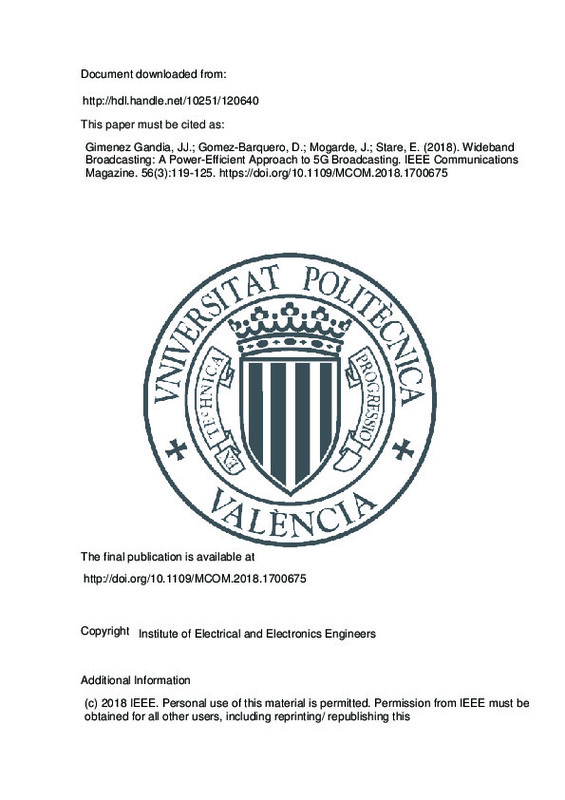Gimenez Gandia, JJ.; Gomez-Barquero, D.; Mogarde, J.; Stare, E. (2018). Wideband Broadcasting: A Power-Efficient Approach to 5G Broadcasting. IEEE Communications Magazine. 56(3):119-125. https://doi.org/10.1109/MCOM.2018.1700675
Por favor, use este identificador para citar o enlazar este ítem: http://hdl.handle.net/10251/120640
|
Título:
|
Wideband Broadcasting: A Power-Efficient Approach to 5G Broadcasting
|
|
Autor:
|
Gimenez Gandia, Jordi Joan

 Gomez-Barquero, David
Mogarde, Javier
Stare, Erik
Gomez-Barquero, David
Mogarde, Javier
Stare, Erik
|
|
Entidad UPV:
|
Universitat Politècnica de València. Instituto Universitario de Telecomunicación y Aplicaciones Multimedia - Institut Universitari de Telecomunicacions i Aplicacions Multimèdia
Universitat Politècnica de València. Departamento de Comunicaciones - Departament de Comunicacions
|
|
Fecha difusión:
|
|
|
Resumen:
|
[EN] Efficient and flexible use of spectrum will be inherent characteristics of fifth-generation (5G) communication technologies with native support of wideband operation with frequency reuse 1, i.e. all transmit sites use ...[+]
[EN] Efficient and flexible use of spectrum will be inherent characteristics of fifth-generation (5G) communication technologies with native support of wideband operation with frequency reuse 1, i.e. all transmit sites use all available frequency resources. Although not from the very first 5G release of 3GPP (Third Generation Partnership Project), it is expected that broadcast/multicast technology components will later be added and fully integrated in the 5G system. The combination of both wideband and frequency reuse 1 may provide significant gains for broadcast transmissions in terms of energy efficiency, since it is more efficient to increase capacity by extending the bandwidth rather than increasing the transmit power over a given bandwidth. This breaks with the traditional concept of terrestrial broadcast frequency planning, and paves the way to new potential uses of UHF (Ultra High Frequency) spectrum bands for 5G broadcasting. This paper provides an insight into the fundamental advantages in terms of capacity, coverage as well as power saving of wideband broadcast operation. The role of the network deployment, linked to frequency reuse in the UHF band, and its influence in the performance of a Wideband Broadcasting system are discussed. The technical requirements and features that would enable such power-efficient solution are also addressed.
[-]
|
|
Palabras clave:
|
Wideband broadcasting
,
Digital terrestrial television
,
Green communications
,
5G
,
Frequency reuse
,
EMBMS
|
|
Derechos de uso:
|
Reserva de todos los derechos
|
|
Fuente:
|
IEEE Communications Magazine. (issn:
0163-6804
)
|
|
DOI:
|
10.1109/MCOM.2018.1700675
|
|
Editorial:
|
Institute of Electrical and Electronics Engineers
|
|
Versión del editor:
|
http://doi.org/10.1109/MCOM.2018.1700675
|
|
Código del Proyecto:
|
info:eu-repo/grantAgreement/MINECO//TEC2014-56483-R/ES/TECNOLOGIAS DE RADIODIFUSION DIGITAL EXTRA-TERRESTRES/
info:eu-repo/grantAgreement/EC/H2020/761498/EU/Broadcast and Multicast Communication Enablers for the Fifth-Generation of Wireless Systems/
info:eu-repo/grantAgreement/EC/H2020/731932/EU/Transforming Transport/
|
|
Descripción:
|
(c) 2018 IEEE. Personal use of this material is permitted. Permission from IEEE must be obtained for all other users, including reprinting/ republishing this
|
|
Agradecimientos:
|
This work was supported in part by the European Commission under the 5G-PPP project 5G-Xcast (H2020-ICT-2016-2 call, grant number 761498). The views expressed in this contribution are those of the authors and do not ...[+]
This work was supported in part by the European Commission under the 5G-PPP project 5G-Xcast (H2020-ICT-2016-2 call, grant number 761498). The views expressed in this contribution are those of the authors and do not necessarily represent the project. This work was also partially supported by the Ministerio de Educacion y Ciencia, Spain (TEC2014-56483-R), co-funded by European FEDER funds.
[-]
|
|
Tipo:
|
Artículo
|







![[Cerrado]](/themes/UPV/images/candado.png)


